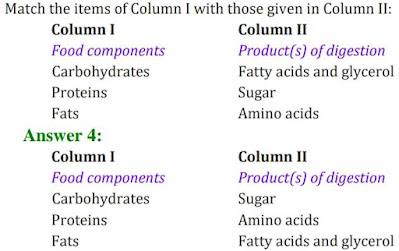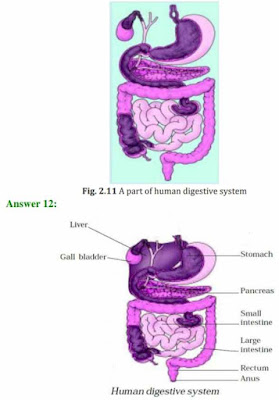NCERT Solutions for Class 7 Science Chapter 2 Nutrition In Animals are provided here with simple step-by-step explanations. These solutions for Nutrition In Animals are extremely popular among class 7 students for Science Nutrition In Animals Solutions come handy for quickly completing your homework and preparing for exams. All questions and answers from the NCERT Book of class 7 Science Chapter 2 are provided here for you for free. You will also love the less ad-free experience on EDU-Favor NCERT Solutions. All NCERT Solutions for class 7 Science are prepared by experts and are 100% accurate.
Latest NCERT Solutions Class 7th Science Chapter 2 (Nutrition in Animals)
Question 1: Fill in the blanks:
(a) The main steps of nutrition in humans are __________, __________, __________, _________ and
__________.
(b) The largest gland in the human body is __________.
(c) The stomach releases hydrochloric acid and ___________ juices which act on food.
(d) The inner wall of the small intestine has many finger-like outgrowths called _________.
(e) Amoeba digests its food in the ____________.
Answer 1:
(a) The main steps of nutrition in humans are ingestion, digestion, absorption,
assimilation and egestion.
(b) The largest gland in the human body is liver.
(c) The stomach releases hydrochloric acid and digestive juices which act on food.
(d) The inner wall of the small intestine has many finger-like outgrowths called villi.
(e) Amoeba digests its food in the food vacuole.
Question 2: Mark (T) if the statement is true and (F) if it is false:
(a) Digestion of starch starts in the stomach. (T/F)
(b) The tongue helps in mixing food with saliva. (T/F)
(c) The gall bladder temporarily stores bile. (T/F)
(d) The ruminants bring back swallowed grass into their mouth and chew it for some
time. (T/F)
Answer 2:
(a) Digestion of starch starts in the stomach. (False)
(b) The tongue helps in mixing food with saliva. (True)
(c) The gall bladder temporarily stores bile. (True)
(d) The ruminants bring back swallowed grass into their mouth and chew it for some
time. (True)
Latest NCERT Solutions for Class 7 Science Chapter 2 - Nutrition In Animals |
Question 3: Tick (√) mark the correct answer in each of the following:
(a) Fat is completely digested in the
(i) stomach (ii) mouth (iii) small intestine (iv) large intestine
(b) Water from the undigested food is absorbed mainly in the
(i) stomach (ii) food pipe (iii) small intestine (iv) large intestine
Answer 3:
(a) Fat is completely digested in the (iii) small intestine.
(b) Water from the undigested food is absorbed mainly in the (iv) large intestine.
Question 4:
Question 5: What are villi? What is their location and function?
Answer 5:
The inner walls of the small intestine have thousands of finger-like outgrowths. These are called villi (singular villus).
The villi increase the surface area for absorption of the digested food. Each villus has a network of thin and small blood vessels close to its surface. The surface of the villi absorbs the digested food materials.
Latest NCERT Solutions for Class 7 Science Chapter 2 - Nutrition In Animals |
Question 6: Where is the bile produced? Which component of the food does it help to digest?
Answer 6:
Liver (the largest gland in human body) secretes bile juice that is stored in a sac called the gall bladder. The bile helps in the digestion of fats.
Question 7: Name the type of carbohydrate that can be digested by ruminants but not by humans. Give the reason also.
Answer 7:
Cellulose (a type of carbohydrate) can be digested by ruminants but not by humans
because ruminants have a large sac-like structure called rumen between the oesophagus and the small intestine. The cellulose of the food is digested here by the action of certain bacteria which are not present in humans.
Question 8: Why do we get instant energy from glucose?
Answer 8:
In the cells, glucose breaks down with the help of oxygen into carbon dioxide and water, and energy is released.
Question 9: Which part of the digestive canal is involved in:
(i) absorption of food ________________.
(ii) chewing of food ________________.
(iii) killing of bacteria ________________.
(iv) complete digestion of food ________________.
(v) formation of faeces ________________.
Answer 9:
(i) absorption of food small intestine.
(ii) chewing of food buccal cavity (Mouth).
(iii) killing of bacteria stomach.
(iv) complete digestion of food small intestine.
(v) formation of faeces large intestine.
Latest NCERT Solutions for Class 7 Science Chapter 2 - Nutrition In Animals |
Question 10: Write one similarity and one difference between the nutrition in amoeba and human beings.
Answer 10:
Similarity: The basic process of digestion of food and release of energy is the same
in amoeba as well as in human beings. In amoeba, Digestive juices are secreted
into the food vacuole. They act on the food and break it down into simpler
substances. Gradually the digested food is absorbed. Similarly, in human beings
various digestive juices (mouth, stomach, intestine etc.) act on food and break it
down to simpler substances.
Difference: The digestion process in amoeba is simple while in human beings it is
a complex process. The process of ingestion and egestion are also quite different.
Amoeba engulf its food by surrounding the food particle with its pseudopodia. The
undigested food which is largely carbon dioxide gas is expelled outside by the
vacuole. While in human beings, the food (which is complex substance) is taken
inside the mouth and undergoes a complex process of digestion and absorption.
Finally the undigested food it expelled in the form of faeces.
Question 11: Match the items of Column I with suitable items in Column II
Question 12: Label Fig 2.11 of the digestive system.
Question 13: Can we survive only on raw, leafy vegetables/grass? Discuss.
Answer 13:
Raw leafy vegetables and grass are rich in cellulose, a type of carbohydrate. Many animals, including humans, cannot digest cellulose, because they do not have enzymes and certain type of bacteria which can digest cellulose. We cannot survive by taking vegetables in raw form. That's why we boil or cook vegetables which breaks down cellulose into simple carbohydrates. We can only survive by taking in vegetables in boiled/cooked form.
I hope you'll learn all about:- NCERT Solutions for Class 7 Science Chapter 2 - Nutrition In Animals | Latest NCERT Solutions for Class 7th Chapter 2 Nutrition in Animals Question Answers | कक्षा 7 विज्ञान अध्याय 2 प्रश्न उत्तर | EDU-Favor






Please do not enter any spam link in the comment box.